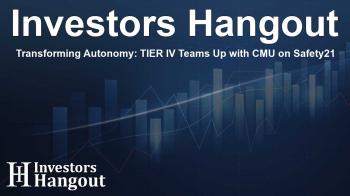Transforming Autonomy: TIER IV Teams Up with CMU on Safety21

Transforming Autonomy: TIER IV and CMU's Strategic Partnership
TIER IV, an impressive name in the autonomous driving sphere, is embarking on a transformative journey by partnering with Carnegie Mellon University (CMU). This collaboration aims to push the boundaries of autonomy through the innovative Safety21 initiative. As the first open-source software for autonomous driving, TIER IV is at the forefront of making Level 4+ autonomy a reality.
Understanding Level 4+ Autonomy
The concept of Level 4+ autonomy sits delicately between traditional Level 4 and Level 5 autonomy. It retains operational control, removing the need for human intervention in dynamic driving tasks, yet incorporates elements characteristic of Level 5 systems. Such advancements can potentially expand operational design domains (ODDs), allowing vehicles to handle unforeseen scenarios with adeptness.
A Blend of Technologies for Enhanced Performance
TIER IV's collaboration with CMU is set to merge data-centric artificial intelligence (AI) with the best practices from robotics. By utilizing a hybrid architecture, they aim to enhance scalability, safety, and clarity within autonomous systems. This amalgamation promises to shed light on decision-making processes, promoting transparency and accountability.
About the Safety21 Initiative
Safety21 is a notable effort pioneered by CMU under the guidance of Professor Raj Rajkumar. Its goal is to innovate safety in transportation by utilizing technologies that adapt to emerging challenges in the field. This partnership enhances TIER IV's commitment to open-source software, particularly through the Autoware platform.
Project Milestones and Goals
The collaborative efforts are structured as a three-year project, where the first year emphasizes the development of a reference vehicle powered by Autoware. This vehicle will not only be utilized for real-world data collection but will also facilitate extensive experimentation, ensuring that both the project and the wider open-source community benefit from the insights gained.
In the following years, the focus will pivot to creating robust safety mechanisms necessary for the certification of autonomous systems. These systems are pivotal for scaling, explaining, and establishing safety protocols essential for public acceptance and deployment.
Ensuring Trustworthy Implementations
The project will tackle the complexities surrounding end-to-end AI models that promise to elevate Level 4+ capabilities. Key concerns including data requirements and decision-making transparency are critical; thus, team efforts will hone in on refining these models alongside traditional methods. This strategic approach will help develop systems that are not only innovative but ethically accountable.
A Vision for the Future of Mobility
The vision shared by TIER IV and CMU articulates a future where autonomous vehicles not only coexist but thrive within society, ensuring safety and enhancing user experiences. TIER IV's CEO, Shinpei Kato, underscores the significance of this partnership in cementing autonomy in the realm of AI and robotics.
Raj Rajkumar from CMU echoes similar sentiments, emphasizing the step forward in comprehending AI's role in safe and effective autonomous driving. By integrating these progressive technologies, the groundwork for a new era in transportation is laid.
Frequently Asked Questions
What is Level 4+ autonomy?
Level 4+ autonomy represents an evolution between traditional level 4 and level 5 systems, allowing vehicles to perform without human intervention while integrating advanced features typical of level 5 systems.
What role does TIER IV play in this partnership?
TIER IV leads the development of the world’s first open-source software for autonomous driving, collaborating with CMU to enhance Level 4+ autonomy through innovative technologies.
How will Safety21 influence autonomous driving systems?
Safety21 aims to strengthen safety measures in transportation by leveraging state-of-the-art technology and methodologies to address current and future challenges in autonomous driving.
What are the main objectives of the three-year project?
The project focuses on developing an Autoware-based reference vehicle, establishing safety mechanisms for certification, and fostering technological innovation in the autonomous driving ecosystem.
How does this collaboration benefit the open-source community?
This partnership promotes the value of open-source software, allowing insights and advancements to be shared within the community, encouraging collective growth and innovation.
About The Author
Contact Logan Wright privately here. Or send an email with ATTN: Logan Wright as the subject to contact@investorshangout.com.
About Investors Hangout
Investors Hangout is a leading online stock forum for financial discussion and learning, offering a wide range of free tools and resources. It draws in traders of all levels, who exchange market knowledge, investigate trading tactics, and keep an eye on industry developments in real time. Featuring financial articles, stock message boards, quotes, charts, company profiles, and live news updates. Through cooperative learning and a wealth of informational resources, it helps users from novices creating their first portfolios to experts honing their techniques. Join Investors Hangout today: https://investorshangout.com/
The content of this article is based on factual, publicly available information and does not represent legal, financial, or investment advice. Investors Hangout does not offer financial advice, and the author is not a licensed financial advisor. Consult a qualified advisor before making any financial or investment decisions based on this article. This article should not be considered advice to purchase, sell, or hold any securities or other investments. If any of the material provided here is inaccurate, please contact us for corrections.

